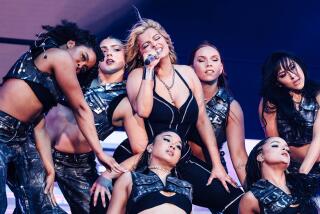Electric Daisy Carnival, EDM thrive on escapist atmosphere

This weekend’s Electric Daisy Carnival in Las Vegas will feature some of the biggest acts in dance music, including Calvin Harris, Tiesto and Avicii.
But even festival promoters readily acknowledge these superstar DJs are not necessarily the major draw here. The acts on stage often take a back seat to the scene itself, where throngs of revelers dance to music driven by pulsing kick drum beats and synthetic, high-energy arrangements.
“It’s the experience. No other festival even compares,” said Randee Heitzmann, 22, of Dallas, an avid fan of electronic dance music who is making her first pilgrimage to the Electric Daisy Carnival. “I’ve been to other festivals and heard this is so much better than anything else. I’ve already seen all but six or seven of the DJ’s playing, but I’m still so excited for the production value.”
Once a fringe genre that grew out of underground clubs and illegal raves, electronic dance music, or EDM, is becoming a dominant feature on the live music scene. Electric Daisy, which sold out two months before the lineup was announced, is expected to draw 400,000 to the Las Vegas Motor Speedway this weekend, making it the biggest-attended multi-day music festival in the U.S.
The event also spills out into pool parties and nightclubs at the big casinos on the Strip, generating an estimated $278 million in economic benefit to the Las Vegas area, according to Beacon Economics.
But it’s not just in Las Vegas. At the Coachella Valley Music and Arts Festival this year, the crowds in the EDM tents and outdoor stages often outnumbered the fans at sets by headliners such as Arcade Fire. Two of the DJ’s at Electric Daisy, Harris and Tiesto, made Forbes’ most recent list of highest-paid musicians. Harris took in an estimated $46 million in record sales and concert tickets, topping better-known stars including Katy Perry and Jay Z.
The trade group Assn. for Electronic Music said EDM festivals have become a $1-billion business worldwide. By comparison, the North American concert market is valued at $5 billion annually.
The appeal is in large part escapism, music industry observers say. Rather than passively watch the acts, EDM fans participate in the concert.
“When people listen to music, it triggers your motor cortex,” said sociologist Yale Fox, a TED fellow who speaks and writes on night life trends. “When everyone is listening to music at the same time, they’re all stimulated in a similar fashion … there’s something magical about everybody moving to the same beat.”
EDM’s escapist pleasures (if there are lyrics, they’re often just exhortations to have the night of your life) and its festivals’ sensory overloads have become so popular and lucrative that they’re eclipsing the artists making the actual songs.
“The fact that it often nearly sells out before any acts are announced says a lot about how synonymous it is with an overall amazing experience and not just about the individual acts,” said Jeremy Olander, a new 23-year-old Swedish producer and DJ playing the festival on Sunday.
“It’s where this original culture comes from — people get excited for the party, for the event,” said Pasquale Rotella, founder of the L.A.-based Insomniac, which stages the Electric Daisy Carnival. “If someone you like is playing, then that’s a bonus.”
Rotella founded Electric Daisy in Los Angeles 17 years ago. But in 2010, a 15-year-old girl attending the rave at the Coliseum died of a drug overdose. The event moved to Las Vegas the following year.
Electric Daisy says it has a no-tolerance policy toward drugs, and fans go through intense bag inspections and pat-downs. Still, violations occur. There were 53 felony arrests at last year’s event, Las Vegas police said, a majority for narcotics charges.
Dance music and its many sub-genres have been youth-culture staples around the world for decades (cities like Ibiza and Berlin have long been dance-music travel destinations). The current EDM wave evokes rave culture of the ‘90s, but gives it a new crowd-sourced spin, one that emphasizes a communal, futuristic experience more than individual artistic triumph.
Seeing the potential for more growth, top-tier promoters like Live Nation have also invested tens of millions in dance promotion firms such as Insomniac. Major record labels like Interscope Geffen A&M and Atlantic have started or revived their dance-music imprints to capitalize on DJs’ newfound pop-star status.
Insomniac controls an increasingly intricate ecosystem of festivals, nightclubs like Create and Exchange LA, and now Insomniac Records, a new imprint on Interscope Geffen A&M. Each is a major bet that electronic dance music, at all levels and styles, will remain an essential part of the youth-music landscape for years to come.
But Insomniac’s rise hasn’t come without problems. Rotella and a second concert promoter are accused of bribery and conspiracy in connection with hundreds of thousands of dollars in payments they made to a Coliseum events manager, who has also been charged in the case. All three have pleaded not guilty and a trial date is tentatively set for early next year.
His own travails aside, Rotella doesn’t see any roadblocks to the growth of EDM.
“It’s about so much more than music,” Rotella said. “It’s about escaping, and dance music is the soundtrack to that.”
More to Read
The biggest entertainment stories
Get our big stories about Hollywood, film, television, music, arts, culture and more right in your inbox as soon as they publish.
You may occasionally receive promotional content from the Los Angeles Times.







